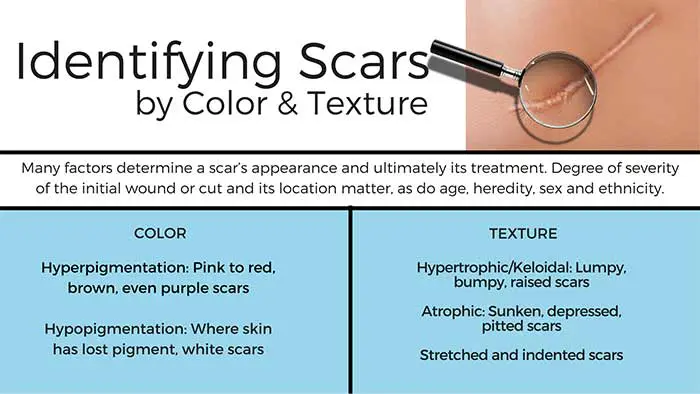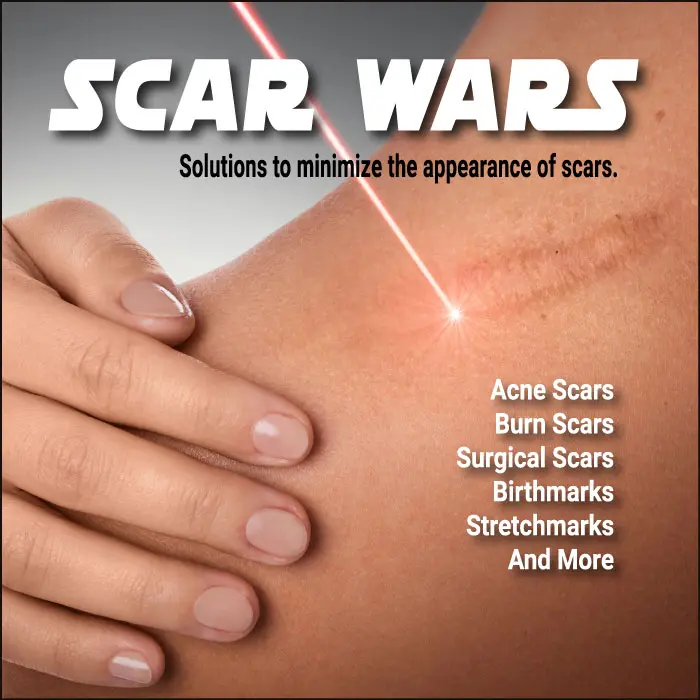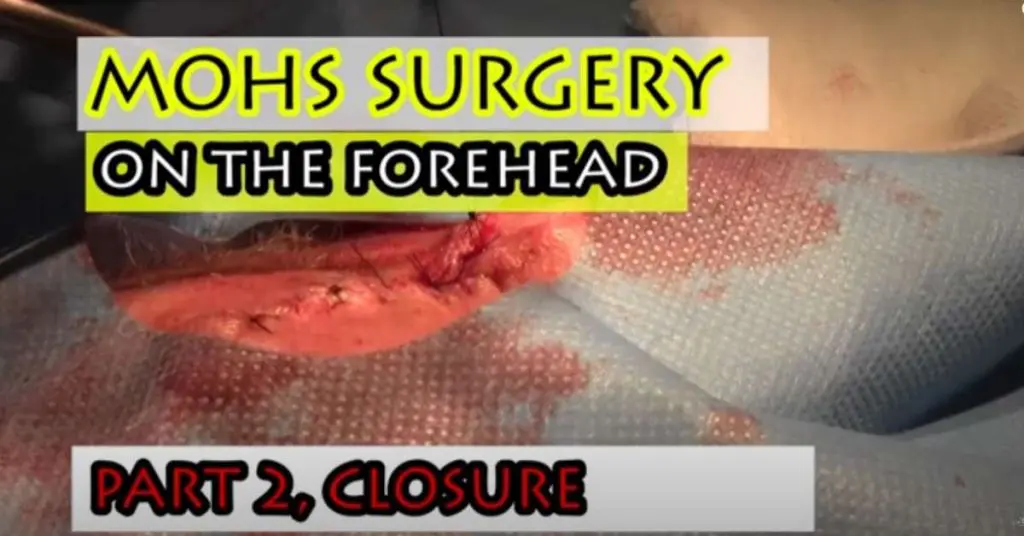Scar Solutions
Minimizing the appearance of Scars
We are passionate in our quest to minimize and improve appearance of scars
Scar Solutions
Minimizing the appearance of Scars
We are passionate in our quest to minimize and improve appearance of scars
Identifying Scars
Ideally we’d all like to keep the smooth and seamless skin we’re born with, but so much can happen to mar an otherwise perfect surface. Over a lifetime cuts, scrapes, burns, trauma brought about by surgery, acne and other skin conditions, even pregnancy can contribute to the formation of scars. Some may be easy to conceal or are so minor only time is required for them to mostly disappear. But what of the variety that results in disfigurement and are not so readily disguised? These can cause real emotional and sometimes even physical pain. The team at Contour Dermatology is passionate in their quest to minimize and improve the appearance of scars.
Whatever the injury, scarring is a natural condition and the final part of the healing process. When the dermis or middle layer of the skin is damaged, the body forms new collagen fibers to repair the site. The end result is a scar. It’s essentially composed of the same collagen as the tissue it replaced, but unfortunately it differs in texture and quality. Scars are very diverse.
Identifying Scars by Color
Pink to red, brown, even purple scars: Cases of darker skin discoloration are known as hyperpigmentation.
White scars: Cases where skin has lost pigment are known as hypopigmentation.
Identifying Scars by Texture
Lumpy, bumpy, raised scars: When the body creates too much collagen at the site, hypertrophic or keloidal scars occur.
Sunken, depressed, pitted scars: When underlying skin support structures such as fat or muscle are lost, atrophic scars occur.
Stretched, indented scars: Commonly referred to as stretch marks are the result of rapid skin expansion – think growth spurts and pregnancy.
Many factors determine a scar’s appearance and ultimately its treatment. Degree of severity of the initial wound or cut and its location matter, as do age, heredity, sex and ethnicity. One thing is certain – a scar is never trivial to the person involved. Contour Dermatology realizes this and considers each circumstance carefully before recommending a course of action. Sometimes a lone method triumphs. Other times a combination of treatments is necessary to achieve optimum results. “What’s exciting is the challenge of making a scar look like normal skin,” says Dr. Jochen. “I not only try to make it look better, I want to make it so no one can ever tell you had a scar.”
Types of Scars
Keloid Scars
When healing is overly aggressive and too much collagen is produced, a raised scar will result. If it extends beyond the original injury, it is known as a keloid scar. These irregularly shaped, hard and rubbery textured scars range in color from pink to red and brown.
- Itchy and painful, they can grow quite large, be rather unsightly and even impede movement.
- Typically they occur after surgery or an accident, but have been known to appear spontaneously or as the result of some minor inflammation like acne.
- Burns, piercings and laser treatments can trigger keloids.
- Can develop at any age but more commonly found in younger people and in darker skinned individuals.
- Earlobes, arms and upper body areas are frequent sites.
Treatment for Keloid Scars
A number of the following treatments must be used in combination to achieve optimum results.
- Steroid injections: a safe and relatively painless way to flatten keloids. Sometimes these injections can stimulate formation of superficial blood vessels making scars appear redder.
- Lasers such as Vbeam® and Excel V™ can help reduce redness.
- Surgery to excise outsized keloids. Since incision can trigger formation of a similar or larger keloid, surgery is often combined with steroid injections and applied pressure dressing.
- The topical cream Aldara has also been shown to decrease the reappearance of surgically excised keloids.
- Compression dressings made of silicone or other materials can effectively flatten a keloid scar by themselves. Good to use in preventative sense after an injury if a patient is prone to forming keloids.
- Cryotherapy: a freezing therapy using liquid nitrogen is often effective on smaller keloid scars.
Hypertrophic Scars
These red and raised scars, like keloids, are the result of excessive collagen production during the healing process. Hypertrophic scars, however, confine themselves to the boundaries of the injury. Burns scars are included in this category.
- Tend to be thick and inflexible. Can restrict movement especially if located close to a joint.
- Arise from the same sort of skin traumas that cause keloids, particularly surgical wounds and burns.
- More common in young adults/teens and occur across racial groups.
- Will improve naturally, shrinking and lightening in color although the process can take a year or more.
Treatment for Hypertrophic Scars
Although hypertrophic scars do improve naturally, shrinking and improving over time, many people choose to hasten the process along using some of the following treatments.
- Steroid injections, including a variety known as Kenalog, work well to reduce inflammation.
- Silicone and hydrogel sheets help flatten hypertrophic scars.
- Fractional CO2 laser therapy reduces thickness and surface wrinkling.
- Microneedling: use of the Dermaroller or Dermapen® or to smooth out scarred tissue. Dermapen® is an excellent option for darker skin types.
Atrophic Scars
These sunken scars form depressions in the skin due to collagen destruction or when other underlying skin support structures like fat and muscle are lost.
- Appear in the wake of inflammatory conditions such as cystic acne or chicken pox.
- Surgical scars can assume this recessed appearance.
- Can occur anywhere on the body but the facial variety generally cause the most concern.
- Striae or stretch marks fall under this category due to their indented nature. Appear as reddish or purplish lines that eventually lighten. Typically occur in places where larger amounts of fat are stored (abdomen, breasts, thighs) during periods when skin stretches rapidly (pregnancy, significant weight gain, adolescent growth spurts)
Treatment for Atrophic Scars
The most frequently addressed atrophic scars are the ones left in the wake of a severe case of acne. See treatment for Acne Scars.
- Stretch marks
- Topical creams
- Fraxel® Laser
Contracture Scars
Colorwise, these scars run the gamut from pink to red, brown and white.
- Occur as the result of burns. tightening skin and often impairing movement.
- Can involve not only the skin, but muscles and nerves.
Treatment for Contracture Scars
Since they consist of non-elastic scar tissue replacing normal elastic connective tissue, treatments for contracture scars include:
- Physical therapy
- Pressure garments
- Skin graft implantation
Special Scar Categories
Acne Scars
Some acne scars are raised but more often they are atrophic (sunken). The sheer range of acne scars has earned them special names based on appearance.
Ice Pick: deep pits extending into the skin as if punctured by an ice pick.
Boxcar: shallow or deep angular scars with sharp vertical edges
Rolling: wide and shallow scars, caused by damage under the surface giving skin a wave-like appearance.
Treatment for Acne Scars
Combinations of the following treatments are usually needed to achieve optimum results.
Minor surgical solutions include:
- Subcision: a surgical solution that levels the skin.
- Punch Grafting: a technique where the scar is cut out. Then a skin graft, usually taken from behind the ear, is used to fill the void.
- Punch Elevation: a technique where the scar tissue is pinched, the base of the scar raised and the surrounding tissue sutured to seal off the site.
Laser resurfacing therapies include:
- Fractional CO2 lasers direct short-pulsed light energy at irregular skin removing damage layer by layer.
- Fraxel® Laser is a less aggressive alternative to fractional CO2..
- Smoothbeam/Excel V Laser stimulates collagen production which can improve the look and feel of scars.
Other select treatments include:
- Dermabrasion: a procedure that removes top layers of skin, in effect “sanding down” acne scars. At Contour Dermatology, we perform Vibradermabrasion which uses a vibrating paddle instead of crystals.
- Microneedling: use of the Dermaroller or Dermapen® or to smooth out scarred tissue. Dermapen® is an excellent option for darker skin types.
- Injection of fillers like Restylane, Perlane and Juvéderm to plump up depressed scars.
- TCA Chemical Peel: can improve the appearance of rolling or depressed acne scars.
Burn Scars
Most burn injuries affect only the top layer of the skin causing red and hypertrophic (raised) scars. More severe burn injuries can produce contracture scars that extend deeper, affecting muscles and nerves, tightening skin and impairing mobility.
Burn scars, in general, need to be closely monitored as affected patients run an increased risk of developing squamous cell carcinoma or an even more aggressive form known as Marjolin’s ulcer.
Treatment for Burn Scars
The severity of a burn and resulting scar dictates treatment. Some of the methods for improving a burn scar’s appearance include:
- Antibiotic Creams – prescription and non-prescription varieties are available
- Fractional CO2 laser therapy including Fraxel® Laser
- Microneedling: use of the Dermaroller or Dermapen® or to smooth out scarred tissue.
Road Rash Scars
These scars are usually incurred in accident situations that revolve around skateboarding, mountain biking and similar pursuits where skin makes contact with asphalt or gravel and absorbs it.
Treatment for Road Rash Scars
- Chemical Peels
- Retina-A
- Topical Creams
Hypopigmented Scars
A thin white scar is the result of natural healing and a reduction of melanin, the substance responsible for pigmentation of the skin. This type of scar is one of the most difficult to reverse.
Treatment for Hypopigmented Scars
- Silicone sheeting can prevent hypopigmentation if used early in the healing process
- The use of Latisse in combination with other therapies such as fractional lasers has delivered results.
- Excimer Laser (308 nonmeter wavelength) has helped some hypopigmented scars
- Surgical grafting of pigmented skin to non-pigmented areas.
- Microneedling – use of Dermapen®
- Reactivating the wound and treating it alternately with other methods.
A Round-Up of Scar Treatment Options and Applications
Chemical Peels – TCA (trichloroacetic acid) chemical peels for acne scars and hyperpigmentation
Cryotherapy – a freezing therapy using liquid nitrogen for smaller keloid scars.
Dermabrasion – a procedure that removes top layers of skin, in effect “sanding down” acne scars. Treats hyperpigmentation as well.
Dermapen – a form of microneedling, effective on hypertrophic and atrophic scars.
Dermaroller – a form of microneedling, effective on hypertrophic and atrophic scars.
Fillers – Restylane, Perlane, Juvéderm, Radiesse or Fat Transfer used to plump up atrophic (depressed) scars, as in the case of acne, also stretch marks.
Lasers – Fractional CO2, Fraxel®, Smoothbeam, Vbeam®, IPL, Medlite C6 lasers for hypertrophic and atrophic scars including those related to acne, stretch marks and hyperpigmentation
Latisse – used in combination with fractional laser therapy has shown promise on hypopigmented scars.
Retin-A – A topical derivative of vitamin A available by prescription only. Most effective against shallow acne scars and post-inflammatory hyperpigmentation. Stimulates the production of collagen. Can be helpful in relieving the pain and itching associated with keloids and hypertrophic scars.
Steroid Injections – a variety known as Kenalog is used to flatten out hypertrophic and keloid scars.
Silicone Sheeting – reduces keloid and hypertrophic scars including surgery scars from tummy tucks, breast augmentation or reduction and other cosmetic and non-cosmetic procedures such as C-section.
Surgical Excision – in the case of keloid scars, where an incision is made and the scar is cut out.
Punch Grafting – For depressed acne scars. A technique where the scar is cut out, then a skin graft, usually taken from behind the ear, is used to fill the void.
Punch Elevation – For depressed acne scars. A technique where the scar tissue is pinched, the base of the scar raised and the surrounding tissue sutured to seal off the site.
Topical Creams –
Prescription varieties:
- Aldara Cream has been shown to decrease the reappearance of surgically excised keloids.
- 5-Fluorouracil Cream (5-FU) – typically used to treat skin cancers, it decreases collagen production and has proven helpful on some hypertrophic scars.
Non-prescription:
- Mederma, a gel based on an onion extract. Its marketing claims to make make scars “softer, smoother and less noticeable.
- Bleaching Creams – a variety exist on the market to help diminish hyperpigmented scars.
- Vitamin E – Special Note: Studies have shown that topically applied vitamin E does NOT help in improving the cosmetic appearance of scars and leads to a higher incidence of an allergic reaction known as contact dermatitis.
Vermadermabrasion– a form of dermabrasion that uses a vibrating paddle.
Concealment of Scars
Camouflage Makeup
- Dermablend: a light, full-coverage foundation that can cover a variety of scars on the face and body.
- Jane Iredale Mineral Makeup: Concealer and corrective color system available at Contour Dermatology.
Tattooing a Scar – NEVER a good idea. The exact pigment can never be matched. Tattoos fade over time and skin pigment changes throughout the year.




















